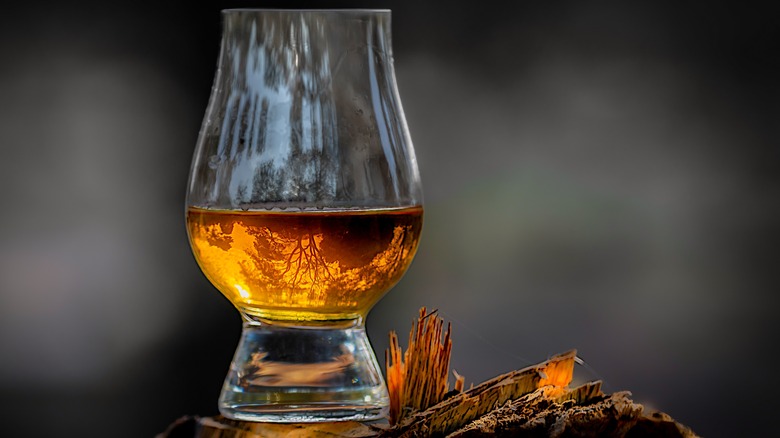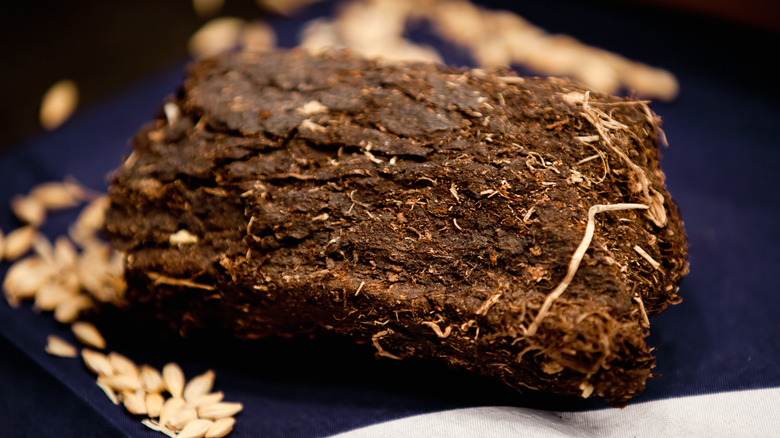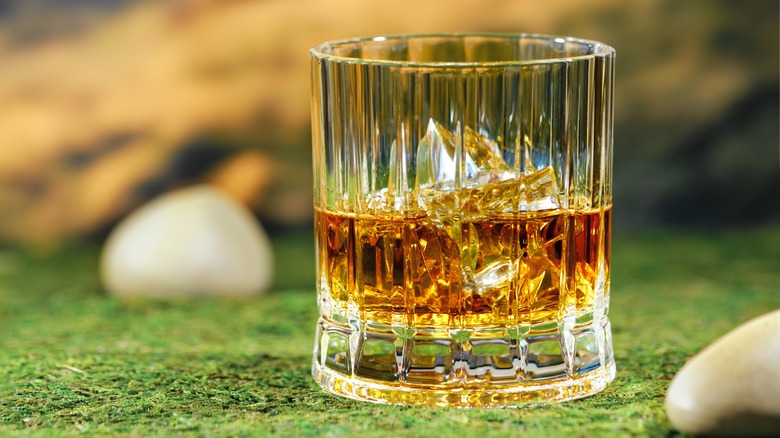What Does Peat Mean When It Comes To Whiskey?
Whiskey is a complex and varied spirit. It's crafted from a range of fermented grains, that are then distilled through unique methods, and subsequently aged in different barrels. Throw in that whiskeys are then blended together, and produced in regions spanning the globe, and it's easy to see the spirit's grand scope.
Many categorizations are used to delineate styles, but an especially distinguishable descriptor is that a whiskey is peated. Such an attribute can be a bit polarizing — not every drinker loves the robust smoky flavors, but there's an alluring magic to its complexity. It immediately draws associations to a Scotch, indeed the most celebrated rendition. However, peat means much more to whiskey than a flavor or regional quirk.
Rather, peat is a dense decomposed plant matter that was once the fuel source for all whisky distillation in Ireland and Scotland, the two historical origins of the spirit, where the spelling doesn't use the "e" in whisky as does the American spelling. Today, it's used for drying malt imparting expansive flavor possibilities in the process. Its flavors include everything from sweetness to mineral and earthy qualities, a terrific showcase of what's in the local soil. With the substance used in the U.S., India, Japan, New Zealand, and Taiwan in addition to Scotland, the method is a great way to sample many bold whiskeys, while noting terroir in the process.
Peat flavors whiskey through the malt drying process.
Peat is a fascinating substance that lends complex contributions to the spirit. Like a proto-fossil fuel, it consists of thousands of years old decomposed plant material. With a hollow composition, it's commonly found in a swamp, or similarly moist environment — hence abundance in the wet climates of Ireland, Scotland, and Japan. And most crucially, peat is high in carbon, which makes it an ideal fuel source.
Initially, peat was burned to power the still, but nowadays, it's more prominently employed to dry malt. In the most traditional method, the grain — typically barley in the case of Scotch — is laid across a drying floor, while underneath, peat is ignited in a kiln. Over many hours, the gentle heat dries the grains, halting germination, all the while infusing the malt with the smokey, complex flavor. The amount of peat flavor integrated is controlled: each producer has their own standards for the resultant malt.
Today, many distilleries combine peat with other heat sources and also utilize drying methods other than the floor. Nevertheless, the art of peating continues, producing a range of delicious results. So especially if you're drinking a Scotch, the process is likely involved even in the must-know whiskey brands.
The palate of peat impacts whiskey in intricate ways
Since peat is introduced to the grains by way of fire, it's no surprise its tones are predominantly smoky. However, it's a multidimensional flavor that depends on both the employed peat, as well as quantity. Flavor notes cover a large spectrum, often described as spiced, mineral, marine, medicinal, and more.
For instance, the Scottish island of Islay is especially known for its peated whisky, since the compound is abundant locally. Here, peat inspires marine flavors, with notes of iodine and seaweed, all punctuated with heavy smoke. Meanwhile, peat sourced from the highlands brings more wood-like notes, with a bolder richness. And Japanese whisky — which is a Costco fan favorite — offers a more delicate tinge of fire.
The concentration of peat is measured through phenols, tracked in parts per million. Whiskies cover the full range, with producers like Islay-based Bruichladdich especially known for their heavy peat use, while other brands may just have a small tinge in a blend. Note such a measurement for some estimate of the boldness. Nevertheless, knowing the variety and the amount of peat a Scotch is made from won't elude all the details. Since the compound is involved in the process, rather than as an ingredient, it impacts whiskey in intricate ways imbuing the spirit with a smoky, aromatic, and mysterious appeal.


